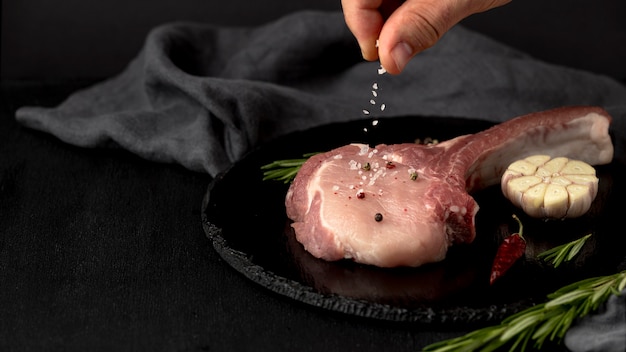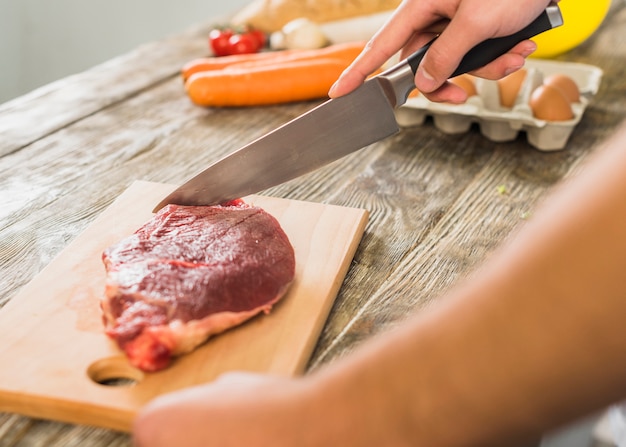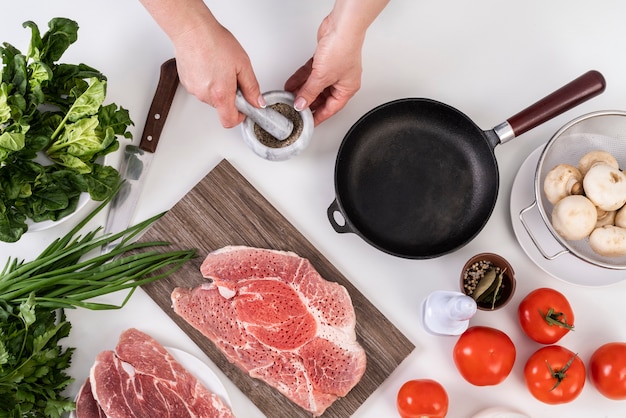Ah, beef fillet. It’s the crown jewel of the meat world, a succulent, tender cut that’s perfect for special occasions and everyday meals alike. But let me tell you, getting it right can be a bit of a dance. Overcook it, and you’re left with a dry, disappointing piece of meat. Undercook it, and you’re playing roulette with food safety.
Over the years, I've learned a thing or two about cooking beef fillet, and let me tell you, it's been a journey. From those early attempts where the fillet ended up more charcoal than steak, to the triumphs of perfectly juicy, tender masterpieces, I've experienced it all. Now, I'm sharing my wisdom with you, breaking down the secrets to cooking this magnificent cut of meat, from understanding doneness to mastering the perfect cooking time. So, grab your apron, get ready to learn, and let's get cooking!
(Part 1) Understanding Doneness

What is Doneness?
Simply put, doneness refers to how cooked your beef fillet is. This is determined by its internal temperature, which in turn influences the level of pinkness and tenderness. There are different levels of doneness, each with its own appeal, ranging from the blushing, rare centre to the well-done, firm bite.
The Spectrum of Doneness:
Finding the perfect doneness is all about personal preference. But here's a guide to help you navigate the levels:
- Rare: 120-125°F (49-52°C). The centre is still very red and cool, offering a soft, almost buttery texture.
- Medium-Rare: 130-135°F (54-57°C). The centre is warm and pink, with a slight resistance when cut. The flavour is rich and juicy, showcasing the beef’s natural flavour.
- Medium: 140-145°F (60-63°C). Pink throughout with a firmer texture, offering a balanced flavour profile that’s both juicy and slightly firmer.
- Medium-Well: 150-155°F (66-68°C). Mostly brown with only a hint of pink at the centre. The texture is firm and the flavour is well-developed, leaning towards a more robust profile.
- Well-Done: 160°F (71°C) and above. Completely brown and cooked through, with a firm bite. This level of doneness offers a less juicy experience, with a more concentrated flavour.
Remember, these are just guidelines. You might find yourself preferring a slightly higher or lower temperature based on your taste and the specific cut of beef. And if you’re unsure about the level of doneness, it's always best to err on the side of undercooked rather than overcooked. You can always cook it a bit more, but you can’t undo overcooking.
(Part 2) Choosing Your Beef Fillet

Quality Counts
The quality of your beef fillet will directly impact the flavour and tenderness of your final dish. Look for a good quality, grass-fed fillet with a rich, deep red colour, a nice amount of marbling (those white streaks of fat that make the meat juicy and flavorful), and a firm, springy texture. Avoid fillets that are pale, dry, or have a strong odour.
Size and Thickness Matters
The thickness of your fillet plays a crucial role in determining cooking time. Thicker fillets take longer to cook through, so consider this when choosing your cut. If you're aiming for a perfectly cooked centre, a fillet that's about 1.5 inches thick is ideal. However, if you prefer a less cooked centre or are working with a smaller fillet, adjust your cooking time accordingly.
If you're unsure about the thickness, don't be afraid to ask your butcher for guidance. They'll know exactly what's best for your chosen cooking method and desired level of doneness.
(Part 3) Preparing Your Beef Fillet

Pat It Dry
Before cooking, pat the fillet dry with paper towels. This is essential for achieving a beautiful, crispy sear. A wet surface will lead to steam instead of browning, resulting in a less-than-ideal outcome.
Seasoning: The Art of Enhancement
Salt and pepper are the classic seasonings for beef fillet, but don't be afraid to get creative! Herbs like rosemary, thyme, and garlic powder can add a wonderful depth of flavour. I personally love a sprinkle of smoked paprika for an extra touch of smoky goodness.
Remember, when it comes to seasoning, less is often more. You want to enhance the natural flavours of the beef, not mask them. And be sure to season generously, allowing the seasoning to penetrate the meat and create a flavourful crust.
The Resting Game
This is a crucial step that many people overlook. Let the fillet rest at room temperature for about 30 minutes before cooking. This allows it to come to a more even temperature, promoting even cooking and preventing overcooking.
Think of it as a little preparation for the big show. Giving your beef fillet a chance to rest allows it to relax and develop its flavours, ensuring a more delicious and satisfying final result.
(Part 4) Cooking Methods: A Journey of Flavour
There are several ways to cook a beef fillet, each offering its own unique flavour and texture. Here are some of the most popular methods:
Pan-Seared Beef Fillet: The Quick and Delicious
This is my go-to method for a quick and delicious meal. It's simple, effective, and delivers a fantastic sear. Here's how to do it:
- Heat a cast-iron pan over high heat. A cast-iron pan retains heat beautifully, creating a perfect sear. If you don't have a cast-iron pan, a heavy-bottomed stainless steel pan will also work well.
- Add a tablespoon of oil. Choose an oil with a high smoke point like grapeseed or avocado oil, which can withstand high heat without burning.
- Sear the fillet for 2-3 minutes per side. You want a nice, deep brown crust that indicates a beautifully caramelized exterior.
- Reduce the heat to medium and cook for another 3-5 minutes per side, depending on your desired level of doneness. Use a meat thermometer to check the internal temperature and ensure it reaches your target range.
- Remove from the pan and let it rest for 5-10 minutes before slicing and serving. This allows the juices to redistribute, resulting in a juicy, flavourful steak.
roast beef Fillet: A Feast for the Eyes
For a more impressive presentation and a beautifully cooked fillet, roasting is the way to go. Here's how to achieve perfection:
- Preheat your oven to 400°F (200°C). A hot oven helps create a beautiful crust while ensuring even cooking.
- Season the fillet generously with salt and pepper. You can also add herbs or spices for additional flavour.
- Place the fillet on a roasting rack in a baking dish. This allows for even heat circulation and prevents the fillet from sitting in its own juices, which can lead to steaming rather than browning.
- Roast for 10-15 minutes, or until the outside is browned. This initial high-heat sear develops a flavourful crust.
- Reduce the oven temperature to 350°F (175°C) and continue roasting until the fillet reaches your desired doneness. Use a meat thermometer to ensure accuracy.
- Remove the fillet from the oven and let it rest for 10-15 minutes before slicing and serving. This crucial step allows the juices to redistribute, resulting in a tender, juicy fillet.
Grilling Beef Fillet: Embrace the Smoky Flavour
Grilling adds a unique smoky flavour to the beef fillet. Make sure your grill is hot (about 450°F/230°C) and clean, for optimal results.
- Season the fillet generously with salt and pepper.
- Grill for 2-3 minutes per side, or until nicely browned. You want that beautiful grill mark for that distinct smoky flavour.
- Reduce the heat to medium and continue grilling, flipping every 2-3 minutes, until the fillet reaches your desired doneness. Use a meat thermometer to ensure you're achieving the desired internal temperature.
- Remove from the grill and let it rest for 5-10 minutes before slicing and serving. This allows the juices to redistribute, creating a tender and flavourful fillet.
No matter which cooking method you choose, remember to use a meat thermometer to ensure accuracy. It's the most reliable way to guarantee your fillet is cooked to your liking.
(Part 5) Cooking Time Chart: A Guide to Timing Perfection
This chart provides a general guideline for cooking times. Always use a meat thermometer to ensure accuracy, as cooking times can vary depending on the thickness of the fillet and the heat of your cooking method.
| Doneness | Internal Temperature (°F) | Internal Temperature (°C) | Cooking Time (per side) |
|---|---|---|---|
| Rare | 120-125°F | 49-52°C | 3-4 minutes |
| Medium-Rare | 130-135°F | 54-57°C | 4-5 minutes |
| Medium | 140-145°F | 60-63°C | 5-6 minutes |
| Medium-Well | 150-155°F | 66-68°C | 6-7 minutes |
| Well-Done | 160°F and above | 71°C and above | 7-8 minutes |
Note: This chart is for a 1.5-inch thick fillet. Adjust the cooking time based on the thickness of your fillet. Thicker fillets will take longer to cook.
(Part 6) The Resting Ritual: Unlocking the Best Flavour
Allowing your beef fillet to rest after cooking is a crucial step that will significantly enhance its tenderness and flavour.
Why? When you cook meat, the juices get pushed to the surface. If you cut into it immediately, these juices will run out, leaving you with a dry, disappointing steak. Resting allows the juices to redistribute throughout the meat, resulting in a tender, juicy, and flavourful steak.
Let your fillet rest for 5-10 minutes before slicing and serving. You'll notice a significant difference in its texture and taste. Resting is an essential part of the cooking process, so never skip this step!
(Part 7) Serving and Enjoying: The Grand Finale
You’ve worked hard to create a culinary masterpiece, now it’s time to enjoy it! Here are some ideas to elevate your beef fillet experience:
- side dish Symphony: Serve your beef fillet with your favourite sides. Roasted vegetables, such as asparagus, broccoli, or Brussels sprouts, offer a delightful contrast in texture and flavour. mashed potatoes or creamy polenta provide a comforting and satisfying accompaniment, while a simple green salad adds a refreshing touch.
- Sauce Magic: A delicious sauce can take your beef fillet to the next level. A classic béarnaise sauce, with its tangy, creamy richness, is a classic pairing. A rich mushroom sauce, bursting with umami flavour, is another excellent choice. For a lighter touch, try a tangy chimichurri, which adds a bright and herbaceous flavour to the beef.
- Wine Pairing: Don't forget the wine! A bold red like Cabernet Sauvignon or Merlot pairs beautifully with the rich flavours of beef fillet. For a lighter option, a Pinot Noir can also complement the dish well.
Remember, the key is to create a symphony of flavours and textures. Don't be afraid to experiment and find what works best for you.
(Part 8) FAQs: Answering Your Burning Questions
Q1: What is the best way to tell if my beef fillet is cooked to my liking?
The best way is to use a meat thermometer. Simply insert the thermometer into the thickest part of the fillet and make sure it's not touching bone. A meat thermometer provides an accurate reading, ensuring you achieve the desired level of doneness.
Q2: What if I overcook my beef fillet?
Unfortunately, you can't "uncook" it. But, you can try to salvage it by adding a flavorful sauce or topping it with something that will add moisture. A rich sauce can help mask the dryness, and a topping like a creamy cheese or avocado can add richness and moisture.
Q3: Can I freeze beef fillet?
Yes, you can freeze it for up to 3 months. However, it's best to freeze it in a vacuum-sealed bag to prevent freezer burn. Freezing can affect the texture slightly, so it's best to thaw the fillet in the refrigerator overnight before cooking to allow it to return to its optimal state.
Q4: How long does it take to defrost beef fillet?
It takes about 24 hours to defrost a fillet in the refrigerator. This slow thawing method allows the fillet to defrost evenly and maintain its quality. You can also defrost it quickly in a cold water bath, making sure the fillet is completely submerged in the water and changing the water every 30 minutes. However, this method can lead to a slight loss of moisture.
Q5: What are some good side dishes to serve with beef fillet?
The possibilities are endless! Here are a few ideas:
- Roasted Vegetables: Asparagus, broccoli, Brussels sprouts, or a medley of colourful vegetables offer a delightful contrast in texture and flavour.
- Creamy Sides: Mashed potatoes or creamy polenta provide a comforting and satisfying accompaniment.
- Fresh Salad: A simple green salad with a vinaigrette dressing adds a refreshing touch and balances the richness of the beef.
- Grain-Based Options: Wild rice pilaf, quinoa salad, or couscous offer a light and flavourful accompaniment.
- Mushroom Delights: Sautéed mushrooms, with their earthy flavour, are a classic pairing for beef fillet.
Now, go forth and conquer the beef fillet! Remember, with a little practice and a dash of confidence, you'll be a pro in no time. And who knows, maybe you'll even be the one sharing your wisdom with others! Happy cooking, everyone!
Everyone is watching

How to Cook Frozen Lobster Tails Perfectly: A Step-by-Step Guide
RecipesLobster. Just the word conjures up images of lavish meals, special occasions, and a taste of luxury. But let's...

Pigs in a Blanket Cooking Time: How Long to Bake for Perfect Results
RecipesAh, pigs in a blanket. Just the name conjures up images of those delightful little parcels of crispy pastry en...

Pork Fillet Cooking Time: How Long to Cook It Perfectly
RecipesPork fillet, or tenderloin as it's sometimes called, is a real favourite in our house. It's so versatile, and...

The Ultimate Guide to Cooking Delicious Frankfurters
RecipesLet's face it, we all love a good frankfurter. It's a classic, simple, and always satisfying. But let's be rea...

Wolf Meat Recipes: A Guide to Cooking Wild Game
RecipesLet's be honest, you don't see wolf meat at your local butcher shop every day. It's a bit of a wild card, but ...
